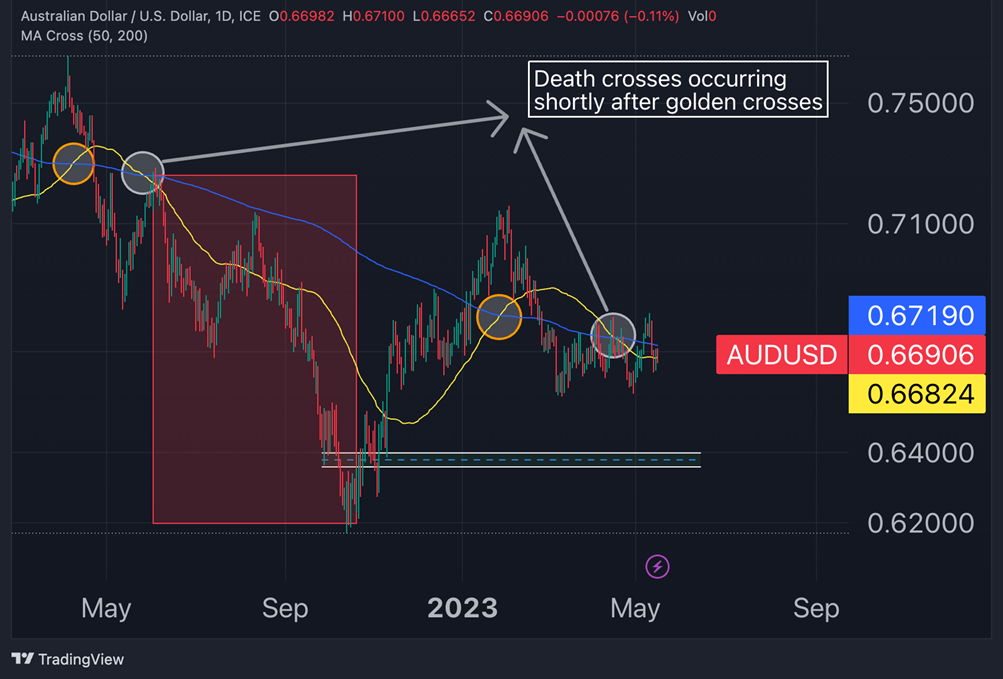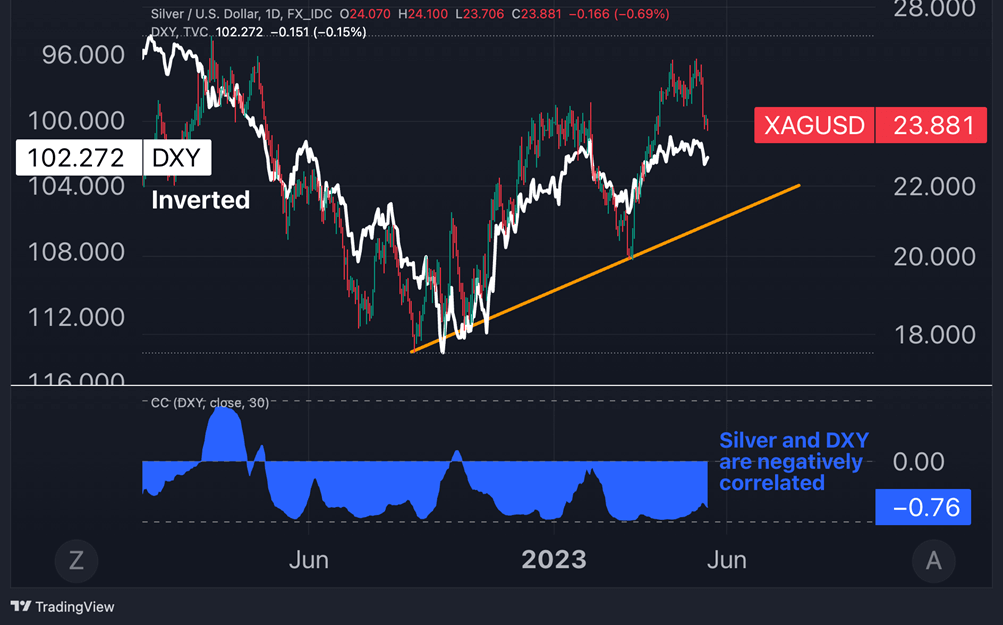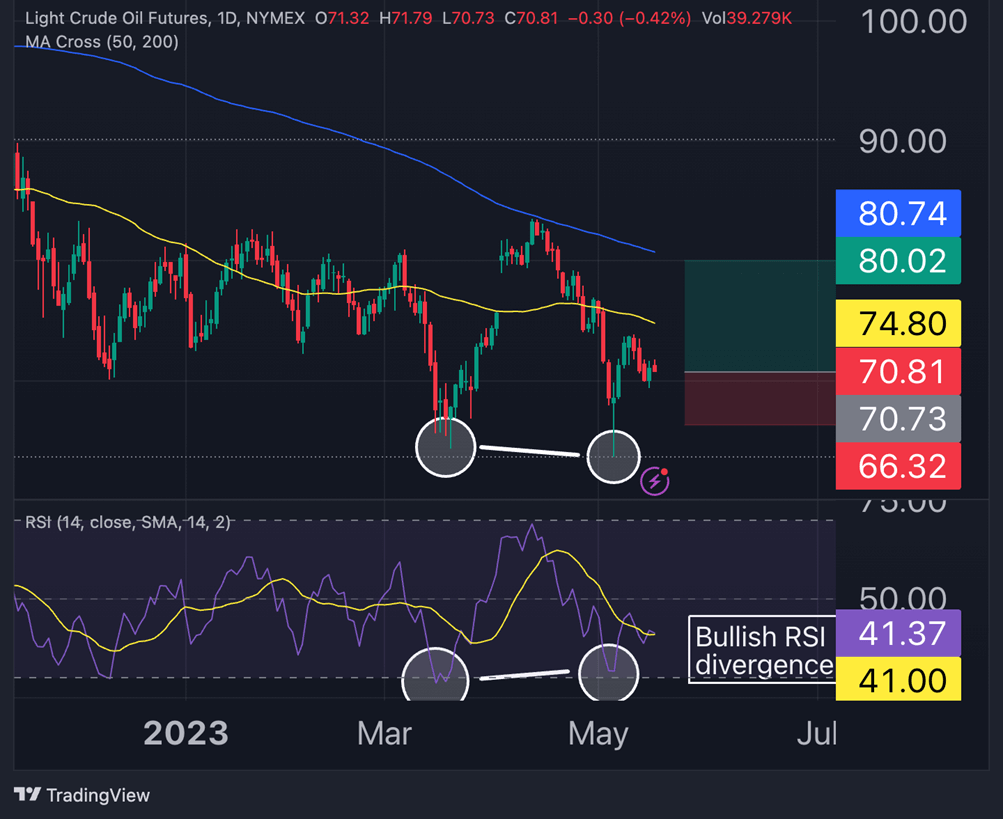Markets have been on a roller coaster ride. Here are our latest forex trading ideas: AUD/USD, Silver, and Oil
Markets overview
Over the previous week, the US dollar gained territory against every major currency, with strong 1.5% gains against high-beta Australian (AUD) and New Zealand (NZD) dollars. This was despite the fact that US inflation surprised to the downside (4.9% versus 5%) and the May’s University of Michigan consumer sentiment survey fell short of forecasts.
May is the second-best month of the year for the US dollar, after January, with the DXY index surging on average 0.4% this month.
The discussions over raising the US debt ceiling are now in the forefront and are having an impact on both the bond and currency markets, putting the stock market aside for the time being.
Yields on one-month Treasury notes reached a new high of 5.7% this week. US Treasury Secretary
Janet Yellen set June 1st as the deadline for Congress to lift the debt ceiling in order to keep the government from running out of money.
If the debt ceiling is effectively raised and the default avoided (base case scenario) that could generate an upward pressure on long-term Treasury yields, thus creating some headwinds for duration-sensitive asset such as the Japanese yen, Swiss franc, gold and silver.
The only notable releases of macro data this week are the US retail sales on Tuesday and the GDP and inflation figures for Japan on Tuesday and Thursday, respectively. However, all eyes will be on many central bank officials who will be appearing, including Fed Chair Jerome Powell, who will speak at a monetary policy conference in Washington on Friday. Christine Lagarde, Governor of the European Central Bank, will also speak after the market closes on Friday.
On Monday, a bunch of Fed speakers (Bostic, Kashkari) pushed back firmly against market expectations of rate cuts this year.
According to CME Group Fedwatch, investors expect the Fed to hold rates unchanged on June 14 with an 80% chance. A rate cut is more likely than not to occur by September, and more than 150 basis points of cuts have been priced by May 2024.
The market consensus is thus that a Fed rate cut cycle will occur soon, since market-based inflation expectations have substantially reversed to the long-term average, with both the 10-year and 5-year US inflation expectations gauges back to 2.2%.
Consequently, surprises and market disruptions may occur if Fed speakers get the message that the market is incorrectly pricing in such a strong rate cut cycle and if new inflationary pressures emerge.
Open trades from past weeks:
- Short EUR/USD: Opened on April 24, at 1.0982; Target Price 1.07; Stop Loss 1.11; P&L current +0.94%
- Long USD/JPY: Opened on April 24, at 134.35; Target Price 138; Stop Loss 132.5; P&L current +1.08%
- Long CAD/JPY: Opened on May 1, at 100.89; Target Price 104.3; Stop Loss 98.05; P&L current +0.05%.
- Short GBP/USD: Opened on May 8, at 1.2654, Target Price 1.227; Stop Loss 1.30; P&L current +1.02%
- Long EUR/JPY: Opened on May 8, at 149.16, Target Price 160; Stop Loss 142; P&L current -0.80%
- Long CAD/NZD: Opened on May 8, at 1.1803, Target Price 1.215; Stop Loss 1.165; P&L current +0.70%
New Trades
AUD/USD Trading Strategy: Death Cross Reappearing
Short AUD/USD: Opened at 0.6690; Target Price 0.636; Stop Loss 0.6825; Risk-reward-ratio of 2.12

The Australian dollar has always been related to risk sentiment, and at a time when investors may be reducing their risk exposure, negative pressure on the AUD/USD pair may resume.
The AUD, in particular, is particularly vulnerable to changes in US 10-year Treasury yields, and if they rise, the Aussie faces significant headwinds.
The most significant signal came from technical indicators, as the 50-day moving average crossed from above to below the 200-day moving average, resulting in the so-called death-cross pattern.
A death cross predicted a significant negative move for the AUD/USD pair in the previous event, which happened in May 2022. The two occurrences are also remarkably similar in that a death cross occurredquickly after invalidating a false golden-cross formation.
We like the region around 0.636 as target, which was a strong support area between September and November, if we exclude the brief bearish spike in October. Stop loss could be placed slightly above the highs reached on May 10 at 0.6825.
Silver (XAG/USD) Trading Strategy: The USD's Preferred Victim
Short XAG/USD: Opened at $23.88; Target Price $22; Stop Loss $24.9; Risk-reward-ratio of 1.82

Silver has started to move lower, with Thursday last week dropping as much as 4.8% on a single session.
We think silver has overextended the bullish trend started in March, and as likely found a near-term top at $26 (May 5’s highs) given that is trading at relatively expensive valuations against the level of the US dollar DXY.
The 30-day correlation between silver and the DXY is strongly negative (-0.76) and thus an upside move in the greenback creates downside pressure for the precious metal.
Our analysis implies that silver needs to reconnect with the USD levels. An interesting support target by the end of June may be placed at around $22, crossing the bullish trendline connecting the higher lows of September and March and implying an 8% downside from current levels. If silver instead moves again above $24.9, a stop will be triggered.
Oil WTI Trading Strategy: Bullish RSI Divergence Formed
Long WTI spot: Opened at $70.8; Target Price $80; Stop Loss $66.3; Risk-Reward-Ratio of 2.2
There both fundamentals and technical arguments currently going in favor of oil prices.
To begin with, the International Energy Agency (IEA) raised its global oil demand projection by 200,000 barrels per day in its May report, predicting tighter market conditions in the second half of the year, with demand predicted to exceed supply by about 2 million bpd.
Second, the US Department of Energy announced plans to acquire up to 3 million barrels of crude oil in order to begin replenishing the Strategic Petroleum Reserve.
China's economic recovery is not moving as quickly as the reopening, leaving potential for easing monetary or fiscal policy, which would be beneficial to oil prices.
Finally, the longer a US recession lacks to arrive, the higher the room for oil to reprice such a negative scenario. In the end, if the Congress hikes the debt ceiling that would be a positive outcome for oil.
Technically, we saw a clear bullish RSI divergence earlier this month, as prices hit a new low of $63.66 a barrel, but with the RSI not reaching prior oversold levels seen in March.
This divergence between prices and momentum oscillator may have signaled a bottom out for oil.
We like going long WTI spot at $70.95, with $80 as a key target for taking profits, implying a 13% upside from here. That level corresponds to post-OPEC+ cuts in April and the 200-day moving average.
A move below $66.3, would prove the strategy wrong and trigger the stop.
The "Basics of Forex Trading" lay the foundation for understanding this intricate financial world, encompassing essential concepts, market dynamics, and foundational strategies that serve as your launchpad for success in currency trading.




